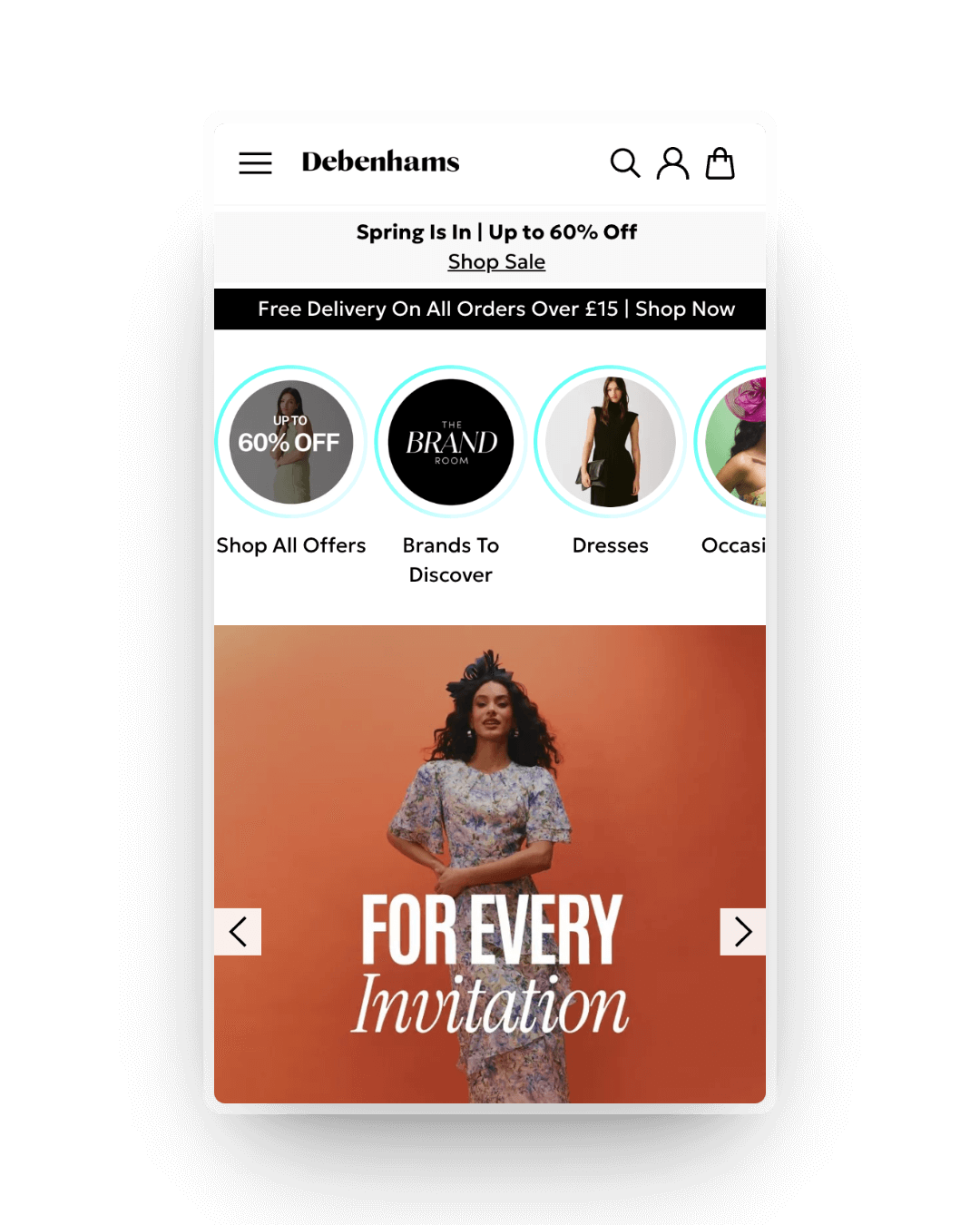Did you know that in 2023, over $2.2 trillion of e-commerce sales happened on mobile devices, according to Statista? If your website isn’t mobile-optimized, you’re missing out on a massive chunk of your customer base. Today’s mobile shoppers crave a seamless, app-like experience – fast, intuitive, and engaging. A subpar mobile website simply won’t cut it anymore.
To deliver this exceptional mobile experience, innovative solutions are needed. Fortunately, the past few years have seen a powerful combination emerge in mobile shopping: Progressive Web Apps (PWAs) and headless commerce. Combined, these innovative technologies can transform your mobile storefront and unlock new levels of customer engagement. The benefits of PWAs for e-commerce platforms are numerous, from speed to offline capabilities, and headless commerce greatly facilitates their implementation. So, buckle up and get ready to discover how PWAs and headless commerce can transform your mobile storefront and drive your business forward.
The Advantages of PWAs for Headless Commerce
So, how do PWAs and headless commerce come together to create a winning mobile shopping experience? Here’s where this combo shines:
- Fast Loading Speeds: Headless commerce separates the frontend presentation layer from the backend data layer. This allows PWAs to leverage service workers, which are essentially scripts that run in the background even when the browser is closed. Service workers can pre-cache essential website elements like product images and static content. When a user visits the PWA, the service worker can deliver this cached content instantly, resulting in lightning-fast load times. This is particularly beneficial for users on slow or unreliable internet connections. Faster loading times directly improve user experience and reduce bounce rates, keeping users engaged and on the path to purchase.
- Fast Loading Speeds
- Offline Functionality
- App-Like Experience
- Reduced Development Costs
- Offline Functionality: Unlike traditional websites, PWAs can function even without an internet connection. The service worker can cache not just static content, but also dynamic data like shopping carts. This allows users to browse products, add items to their cart, and even initiate the checkout process while offline. Once the user regains internet connectivity, the PWA seamlessly synchronises the saved data with the back-end server, ensuring a smooth shopping experience even with interruptions.
- App-Like Experience: PWAs bridge the gap between mobile websites and native apps. They offer an app-like user experience with features like push notifications and home screen shortcuts, allowing users to receive updates and access the platform with a single tap. Unlike native apps, however, PWAs don’t require downloads from app stores. This eliminates the friction of app discovery, download times, and storage limitations often associated with native apps. Additionally, updates to PWAs happen automatically in the background, ensuring users can always access the latest features and bug fixes.
- Reduced Development Costs: Headless commerce architectures often utilize APIs (Application Programming Interfaces) to connect the frontend and backend. This allows for a single codebase to be used across multiple platforms, including web, mobile, and even wearables. This reduces development and maintenance costs compared to building and maintaining separate native apps for each platform.
Seamless Integration With Headless Commerce
The magic behind PWAs and headless commerce lies in their seamless integration. Here’s how this architecture unlocks a world of possibilities:
- Decoupled Frontend: Headless commerce separates the presentation layer (the PWA) from the backend logic (Salesforce Commerce Cloud in this case). This allows you to build and customize the PWA frontend using modern JavaScript frameworks like React, Vue.js, or Angular. This flexibility empowers you to create a cutting-edge user experience tailored to your brand and customer needs, unbound by the limitations of traditional e-commerce platforms.
- API Connectivity: The communication between the PWA frontend and the headless backend (Salesforce Commerce Cloud) is facilitated by APIs (Application Programming Interfaces). These APIs act as messengers, allowing the PWA to request and receive data from the backend in real-time. This ensures your PWA displays accurate product information, pricing, inventory levels, and shopping cart details. Think of it as a waiter relaying your order to the kitchen and bringing back your food. Similarly, APIs ensure seamless communication between the customer-facing PWA and the commerce functions handled by Salesforce Commerce Cloud.
Benefits for Salesforce Commerce Cloud Users:
For businesses using Salesforce Commerce Cloud, PWAs and headless commerce offer a compelling combination:
- Modern Frontend, Robust Backend: You can leverage the power and scalability of Salesforce Commerce Cloud for complex product data management, order fulfillment, and security, while simultaneously building a modern, user-friendly PWA storefront with a framework like React. This allows you to focus on creating a best-in-class customer experience without compromising on back-end functionality.
- Faster Development Cycles: Decoupled architecture allows for independent development of the PWA frontend. This means you can make changes and iterate on the user interface more quickly, without relying on updates to the backend commerce platform. This agility allows you to adapt to changing trends and customer needs faster.
- Omnichannel Consistency: The headless approach enables you to build PWAs that share the same codebase with your web storefront. This ensures a consistent brand experience across all touchpoints, whether customers are browsing on a desktop, mobile device, or tablet.
In essence, by combining PWAs with headless commerce, Salesforce Commerce Cloud users can unlock a future-proof mobile shopping experience that delivers exceptional performance, customization, and scalability.

Is Your Salesforce Commerce Cloud Slowing You Down? 5 Signs It’s Time for a Change
Key Features of PWAs With Headless Commerce
Now that we’ve explored the integration advantages of PWAs and headless commerce, let’s delve into the key features that make PWAs a powerful tool for mobile shopping experiences.
Responsive design is at the core of PWAs, ensuring your mobile storefront adapts seamlessly across various devices, from smartphones and tablets to laptops and desktops. Regardless of screen size or orientation, users will receive an optimal experience. PWAs go beyond static web pages, leveraging modern web technologies to create interactive and immersive user interfaces. Smooth animations, intuitive navigation, and multimedia content can significantly enhance user engagement and drive conversions. Imagine a PWA where you can virtually explore a product in 3D or experience a seamless checkout process with minimal clicks. These functionalities are all within reach with PWAs.
“Imagine a PWA where you can virtually explore a product in 3D or experience a seamless checkout process with minimal clicks. These functionalities are all within reach with PWAs.”
Speed is king in mobile commerce, and PWAs excel in this area with various performance optimization techniques. Techniques like lazy loading of assets ensure only the content currently needed is downloaded, minimizing initial load times. Additionally, efficient resource caching allows PWAs to store frequently accessed data locally on the user’s device, resulting in a smooth and responsive browsing experience even with unreliable internet connections.
Unlike native apps hidden within app stores, PWAs are indexed by search engines, meaning your mobile storefront can benefit from organic search traffic. By incorporating relevant keywords and optimizing your PWA’s content, you can increase your discoverability and attract new customers who wouldn’t necessarily find you through app store browsing. This SEO advantage offers another way for PWAs to boost your online presence.
Case Studies and Success Stories: PWAs Driving Mobile Commerce Growth
The power of PWAs and headless commerce isn’t just theoretical. Here are some real-world examples of e-commerce businesses that have leveraged this combination to achieve remarkable results:
1. Lilly Pulitzer: Unifying the Desktop and Mobile Experience
Lilly Pulitzer, a popular women’s clothing retailer, sought to create a seamless shopping experience across all devices. They relaunched their website as a PWA built on Salesforce Commerce Cloud, resulting in:
- 80% increase in mobile traffic
- 33% increase in mobile revenue
This case highlights the effectiveness of PWAs in unifying the user experience between desktop and mobile. By offering a responsive and app-like experience on mobile devices, Lilly Pulitzer was able to attract more mobile shoppers and convert them into paying customers.


2. Debenhams: Headless Commerce Boosts Mobile Revenue
Debenhams, a major British retailer, recognized the need to improve their mobile shopping experience after noticing a high drop-off rate among mobile users. They implemented a headless commerce approach with a React PWA, leading to significant gains:
- 40% increase in mobile revenue
- 20% increase in conversions
Debenhams’ success story emphasizes the power of headless commerce in optimizing mobile shopping journeys. By decoupling the front-end from the back-end, they gained the flexibility to create a PWA that addressed specific mobile user behaviour and ultimately improved conversions.
3. Devialet: PWA Drives Performance and Sales
Devialet, a French high-end audio equipment company, aimed to enhance their online store’s performance and user experience across various devices. They adopted a PWA approach with headless commerce using Front-Commerce. Here are the impressive results they achieved:
- 100% increase in conversion rate due to faster page loading and a mobile-first experience
- 25% decrease in bounce rate attributed to ultra-fast page loading and improved image management
- Lighthouse performance score increased from 70 to 95 reflecting an overall improvement in web performance
Devialet’s case exemplifies the performance benefits of PWAs. The combination of fast loading times, a mobile-optimized experience, and efficient image management resulted in a significant boost in conversions and a more engaged user base.

These compelling case studies showcase the transformative potential of PWAs and headless commerce for e-commerce businesses. From creating unified shopping experiences to boosting mobile revenue and conversions, these innovative technologies are shaping the future of mobile commerce.

More on mobile-commerce:
Mobile Optimization & Headless Commerce: Driving Personalized Customer Journeys
Implementing PWAs with Headless Commerce
Now that you’ve seen the impressive potential of PWAs and headless commerce, you might be wondering how to implement this powerful combination for your own e-commerce platform. Here’s a breakdown of the key considerations:
Technical Considerations:
- Frontend Frameworks: Building the PWA’s frontend requires choosing a suitable approach. Here are two options to consider:
- Traditional Frameworks: Popular options include React, Vue.js, and Angular. Each framework offers its own strengths and development experience. Consider factors like your team’s expertise, project complexity, and desired feature set when making a selection.
- Frontend-as-a-Service (FEaaS): FEaaS platforms can provide a quicker and more streamlined approach to PWA development. They offer pre-built components, headless commerce integrations, and tools to simplify the development process. Front-Commerce is an example of a FEaaS platform specifically designed for building PWAs on top of headless commerce solutions. While FEaaS can be a good option for some businesses, it’s important to weigh the trade-offs between customization and development ease.
- API Integrations: Remember, PWAs rely on APIs to communicate with the headless commerce backend. A crucial aspect is ensuring smooth integration between your chosen PWA framework and the backend APIs of your e-commerce platform. This may involve utilizing SDKs (Software Development Kits) or custom development to facilitate seamless data exchange.
Best Practices:
- Performance Optimization: Speed is paramount for PWAs. Techniques like code splitting, lazy loading of assets, and effective caching strategies are essential for ensuring a fast and responsive user experience. Utilize performance monitoring tools to identify bottlenecks and continuously optimize your PWA.
- User Experience Design: Prioritize a user-friendly and intuitive design for your PWA. Focus on clear navigation, efficient product browsing, and a streamlined checkout process. Utilize service workers effectively to enable offline functionality and push notifications for enhanced user engagement.
- SEO Optimization: Don’t forget search engines! While PWAs aren’t technically “apps,” they can still be indexed and discovered through search. Implement proper SEO practices, including relevant meta descriptions, structured data markup, and a mobile-friendly design to ensure your PWA ranks well in search results.
- Security Considerations: Security is paramount in e-commerce. Ensure your PWA follows secure coding practices and adheres to best practices for handling sensitive user data like payment information. Regularly update your PWA codebase and leverage security features offered by your headless commerce platform.
Future Trends and Innovations
The future of mobile shopping is brimming with innovation, and PWAs and headless commerce are at the forefront of this evolution. Here’s a glimpse of some exciting trends shaping the landscape:
- AI-Powered Personalization: Imagine a PWA that understands your shopping preferences and anticipates your needs. Artificial intelligence (AI) has the potential to personalize the mobile shopping experience to an unprecedented level. PWAs could leverage AI to recommend products, curate personalized product feeds, and even offer chatbot support for a more engaging and frictionless shopping journey.
- Voice Commerce on the Rise: Voice assistants like Siri and Google Assistant are rapidly changing how we interact with technology. PWAs can integrate seamlessly with voice commerce platforms, allowing users to search for products, add items to carts, and even complete purchases using voice commands. This hands-free approach to shopping has the potential to further streamline the mobile experience and attract new customer segments.
- Augmented Reality (AR) for Enhanced Product Visualization: AR technology can revolutionize the way customers interact with products on their mobile devices. PWAs could integrate AR features that allow users to virtually “try on” clothes, visualize furniture in their homes, or explore product details in an interactive 3D environment. This immersive experience can increase customer confidence in online purchases and boost conversion rates.
- Headless CMS for Content Management: Headless content management systems (CMS) are allowing for a more unified content management approach across various touchpoints. By integrating a headless CMS with PWAs and headless commerce, businesses can create a seamless content management experience for product descriptions, blog posts, and other marketing materials. This centralized approach streamlines content creation and ensures consistency across all channels.
The future of mobile shopping looks amazing! PWAs and headless commerce combined with cutting-edge features like AI, voice assistants, and AR will create a more engaging and personalized experience for customers. This will lead to higher sales, a consistent brand experience across all channels, and a more dynamic e-commerce landscape that caters to new customer segments.
